There is a growing sentiment around the league that New York Knicks guard, Immanuel Quickley, could have a significant impact off the bench next season. Damian Lillard endorsed comments made by Ekam Nagra of the Ball Don’t Stop podcast on September 15th, where the podcast stated that Quickley has the craft, flow and creativity to be successful off the bench.
Nagra believes these traits can lead to him becoming the next Lou Williams or Brandon Jennings. Although Immanuel Quickley can become Lou Williams or Brandon Jennings, it’s unlikely to happen this season because of his potential backcourt partner. Quickley spent 82 percent of his minutes last season on the court with Derrick Rose, as the duo averaged 15.9 minutes per game.
Let’s take a look at why expectations for New York Knicks guard Immanuel Quickley should be lowered next season because of his backcourt mate Derrick Rose.
The team performs exceedingly well, shooting 46.3 percent with them on the court on 28.2 shots. The duo helped the team average 36.3 points per game. The team’s scoring average led them to outscore opponents by 5 points per game.
Unfortunately, when you look beneath the surface, the duo’s success is a bit of a façade, as the team shot 38.9 percent from behind the arc when they were on the court together on 10.5 attempts per game. 24.8 percent of those attempts came from Rose, as he averaged 2.6 per game.
Rose is usually a below-average 3-point shooter, as, before last season, he only made 30 percent of his attempts from 2013-2019 on 2.7 shots per game. Rose’s struggles from behind the arc have led to defenders giving him space when he is behind the arc, as 81.5 percent of his threes were uncontested.
Before last season, Rose only made 33.8 percent of his uncontested attempts. However, he saw a massive increase in that category last season, converting 47.6 percent of his attempts on 2.1 shots per game. Rose’s performance on uncontested threes led to him shooting 38.8 percent on 2.6 attempts per game.
Rose’s statistical profile indicates that it is unlikely he will approximate that percentage next season. If Rose regresses to his typical statistics, it will hurt the team dramatically as Quickley won’t have the confidence to pass the ball to Rose.
As a consequence, Quickley is more likely to take a contested shot over the defender. Sadly, Quickley struggled in his rookie campaign on his contested shot attempts, only converting 39 percent on 4.1 attempts per game.
Consequently, the Knicks could experience a significant dip in their 3-point percentage when the duo is on the court. The easiest way to avoid a significant drop in production is to have Quickley be the off-ball guard, as Quickley has a more consistent track record of being a 3-point shooter.
Quickley made 40.9 percent of his attempts in college on 3.7 shots per game. He transferred his 3e-point shooting into the pros, as Quickley converted 38.9 percent of his attempts on 4.7 3-point shots per game.
More importantly, this move would allow Rose to be in his comfort zone at a greater frequency. Rose has spent 49.3 percent of his possessions in the pick and roll averaging 6.9 per game. Rose is shooting 45.4 percent on 5.7 attempts, averaging 6.3 points per game in the pick and roll.
Immanuel Quickley may be forced out of his comfort zone, for better or worse
The only downside is that it will prevent Quickley from becoming a player like Lou Williams, at least for next season. Lou Williams is a player that depends on the pick and roll to do most of his offensive damage.
Williams has averaged 7.9 possessions per game since 2015, shooting 41.2 percent from the field on 5.8 attempts per game. Williams has averaged 7.4 points per game in the pick and roll: more than half of his scoring output. Therefore, it is unlikely that Quickley will become Lou Williams next season due to the deficiencies of his backcourt partner.
If the team wants Quickley to be a pick-and-roll ball-handler next season, they should consider staggering him and Rose. For instance, they could pair him up with Evan Fournier, who is a more consistent 3-point shooter.
Fournier has shot 37.9 percent from behind the arc on 5.1 attempts per game. As a result, it lowers the likelihood that Quickley will have to worry about an extra defender when he is the pick and roll ball handler. Removing an extra defender increases the probability that Quickley is successful. He made 42.9 percent of his uncontested shots last season on 4.9 attempts per game.
In conclusion, Quickley’s statistical performance depends on who his backcourt partner is next season with the Knicks.
